
PROMO!
First order? Get 10% OFF with this code: 1storder
Written by
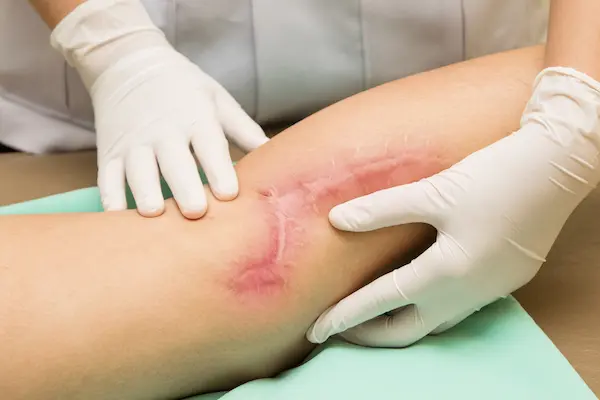
PTD-DBM peptide has drawn attention in research because of its strong link to tissue repair and skin recovery. Early studies suggest that this peptide may activate key proteins that signal cells to begin the healing process. By influencing these pathways, PTD-DBM peptide seems to speed up the body’s natural ability to repair skin damage, with early evidence from animal studies suggesting potential benefits in soft tissues as well.
Researchers studying wound recovery models note that PTD-DBM peptide appears to support cell growth and collagen production, both of which are essential for rebuilding healthy tissue. This makes it an exciting subject in regenerative medicine research, where the focus is on how to restore damaged skin faster and more effectively.
Building on this, it becomes essential to examine how repair is first initiated inside the body at the cellular level.
Explore PTD-DBM Peptide from Peptide Works, a research peptide studied for its role in activating Wnt/β-catenin signaling to support tissue repair and skin regeneration.
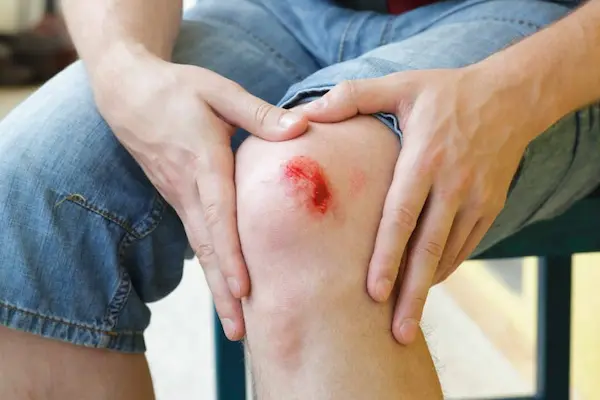
When tissue gets damaged, the repair cycle starts inside individual cells. Injured cells release healing signals that attract support from nearby tissue and immune cells. This early response clears debris and sets the stage for new growth, deciding whether a wound heals quickly or remains fragile.
PTD-DBM peptide has been studied for how it activates repair pathways that guide these first cellular steps. Other research highlights the role of GHK-Cu peptide in supporting regeneration by boosting structural protein balance and encouraging vascular growth, both of which help create conditions for stronger tissue recovery.
Cellular repair provides the groundwork, but effective healing relies on specialized cells that carry out the bulk of reconstruction, most notably fibroblasts.
Discover BPC-157 Peptide from Peptide Works, a synthetic research peptide investigated for promoting angiogenesis, protecting blood vessels, and supporting tendon and wound healing in animal studies.
Fibroblasts are the main cells that rebuild damaged tissue. When an injury happens, they move into the wound area and begin to multiply. These cells guide the framework that holds new tissue together and control how strong or weak the repair becomes.
Changes in the Wnt/β-catenin pathway can affect fibroblast growth and repair activity, and PTD-DBM peptide has been studied for its influence on this process. BPC-157 peptide supports fibroblast migration and resilience under stress, while GHK-Cu peptide contributes to balanced fiber remodeling and better blood supply, helping tissue recover with more strength and flexibility.
The activity of fibroblasts is critical, but their work depends heavily on how well blood vessels supply nutrients and oxygen to injured areas, making angiogenesis another essential factor in tissue repair.
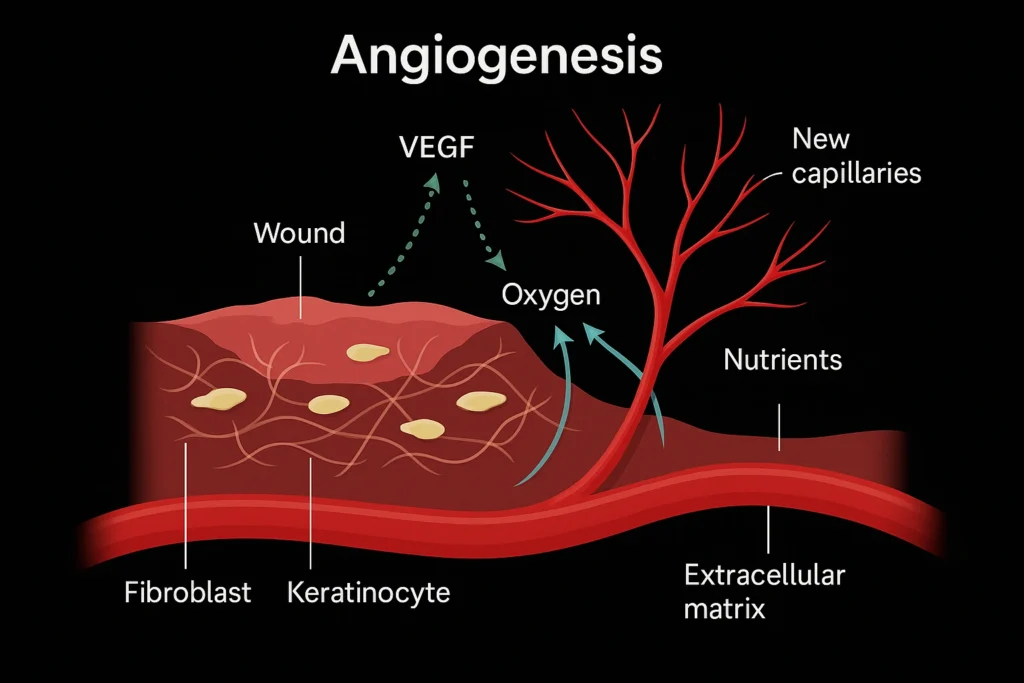
Angiogenesis is the growth of new blood vessels. It starts when signals such as VEGF tell endothelial cells to build fresh capillaries. These new vessels carry oxygen and nutrients into the wound. That support gives fibroblasts and keratinocytes the energy they need to rebuild skin and close tissue gaps. GHK-Cu has been shown in studies to raise VEGF levels and guide these new vessels, improving blood flow where tissue is weak.
Research on BPC-157 suggests it can support vessel integrity and improve circulation in injured tissue, particularly in animal studies. PTD-DBM peptide, by improving repair signals inside cells, helps create conditions where angiogenesis works more effectively.
With stable circulation in place, the next stage of healing depends on the extracellular matrix, which provides the scaffold that organizes and strengthens new tissue.
Shop GHK-Cu Peptide at Peptide Works, a copper-binding peptide widely studied for enhancing collagen production, remodeling the extracellular matrix, and improving skin recovery.
The extracellular matrix (ECM) shapes how wounds close and mature. Collagen and fibronectin provide structure, while proteoglycans control hydration and signaling. As fibroblasts release new fibers, PTD-DBM peptide influences Wnt/β-catenin activity that guides where and how these fibers are placed. This control keeps the scaffold balanced, reducing the risk of weak or excessive tissue.
Remodeling also depends on alignment and breakdown. In tendon repair studies, BPC-157 improved fibroblast migration and helped collagen fibers form organized layers instead of chaotic bundles. At the same time, GHK-Cu stimulated fibroblasts to produce collagen and elastin while supporting vascular networks, ensuring the new ECM connects smoothly with the blood supply and strengthens long-term repair.
The quality of this alignment plays a defining role in whether a wound heals seamlessly or develops into rigid scar tissue.
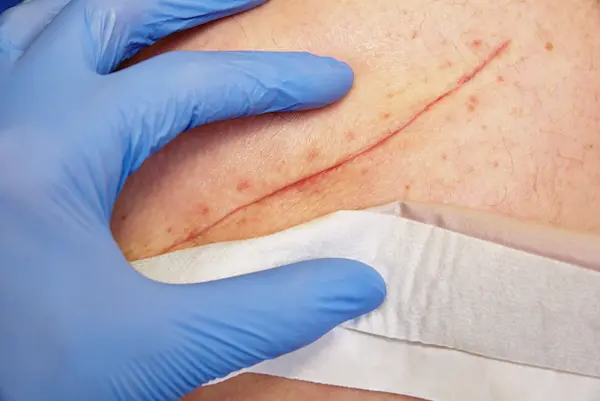
The structure of the extracellular matrix (ECM) defines whether a wound closes with smooth tissue or a rigid scar. When fibers align in an organized pattern, the tissue regains both flexibility and strength. Disordered networks, by contrast, create stiffness and leave scars that are thicker and less functional. Alignment during this stage is a key predictor of the quality of healing.
By modifying cellular signaling, the PTD-DBM peptide may promote matrix patterns that help reduce excessive scarring, as shown in animal studies. BPC-157 supports balanced remodeling, lowering the chance of dense fibrotic tissue. GHK-Cu contributes by improving scar elasticity and vascular integration, helping remodeled skin stay softer and closer to normal in appearance and function.
With scarring closely tied to matrix behavior, researchers are increasingly comparing peptides to see which ones show the most promise for tissue repair and skin recovery.
Researchers often compare BPC-157 and GHK-Cu because each supports repair in different ways. BPC-157 is noted for aiding angiogenesis and circulation stability, making it valuable in studies of tendon and systemic wound healing. In contrast, GHK-Cu peptide is linked to skin recovery, where it helps balance collagen and elastin, improving scar flexibility and cosmetic outcomes.
Alongside these, the PTD-DBM peptide is emerging as an exciting candidate for regulating repair signals at the cellular level. At Peptide Works, we’ve seen growing researcher interest in how these peptides may complement one another in regenerative studies.
| Peptide | Research Focus | Reported Benefits |
|---|---|---|
| BPC-157 | Angiogenesis, tendon & systemic healing | Supports blood vessel stability, reduces inflammation, improves wound and tendon strength |
| GHK-Cu | Skin regeneration, ECM remodeling | Boosts collagen and elastin, improves scar elasticity, enhances cosmetic skin quality |
| PTD-DBM | Cellular repair signaling | Activates Wnt/β-catenin pathways, promotes organized tissue growth, supports regenerative research |
As research compares these approaches, it also points toward the future, where peptides may expand the possibilities of tissue repair and recovery strategies.
The field of regenerative research continues to uncover how peptides shape healing outcomes. PTD-DBM peptide, with its role in cellular signaling, joins BPC-157 and GHK-Cu as promising tools for studying how wounds close, scars form, and skin recovers. Each peptide offers a different pathway for angiogenesis, ECM remodeling, or repair regulation that adds to the growing picture of advanced tissue regeneration.
At Peptide Works, we provide researchers with high-quality peptides to support these important studies. With worldwide shipping and a commitment to reliable products, we aim to help drive discoveries in tissue repair and skin recovery research.
All products discussed are supplied for research purposes only and are not intended for human use.
[1] Lee SH, Kim MY, Kim HY, Lee YM, et al. The Dishevelled-binding protein CXXC5 negatively regulates cutaneous wound healing. J Exp Med. 2015 Jun 29;212(7):1061-80.
[2] Hsieh MJ, Liu HT, Wang CN, Huang HY, et al. Therapeutic potential of pro-angiogenic BPC157 is associated with VEGFR2 activation and up-regulation. J Mol Med (Berl). 2017 Mar;95(3):323-333.
[3] Seiwerth S, Milavic M, Vukojevic J, Gojkovic S, et al. Stable Gastric Pentadecapeptide BPC 157 and Wound Healing. Front Pharmacol. 2021 Jun 29;12:627533.
[4] Pickart L, Margolina A. Regenerative and Protective Actions of the GHK-Cu Peptide in the Light of the New Gene Data. Int J Mol Sci. 2018 Jul 7;19(7):1987.
[5] Pickart L, Vasquez-Soltero JM, Margolina A. GHK Peptide as a Natural Modulator of Multiple Cellular Pathways in Skin Regeneration. Biomed Res Int. 2015;2015:648108.
ALL CONTENT AND PRODUCT INFORMATION AVAILABLE ON THIS WEBSITE IS FOR EDUCATIONAL PURPOSES ONLY.
DISCLAIMER: These products are intended solely as a research chemical only. This classification allows for their use only for research development and laboratory studies. The information available on our Peptide Works website: https://peptide-works.com/ is provided for educational purposes only. These products are not for human or animal use or consumption in any manner. Handling of these products should be limited to suitably qualified professionals. They are not to be classified as a drug, food, cosmetic, or medicinal product and must not be mislabelled or used as such.
Peptide Works
Related Articles

How effective could Orexin Addiction Therapy be?
Have you ever wondered why some people find it so hard to stop addictive habits, even when they truly want
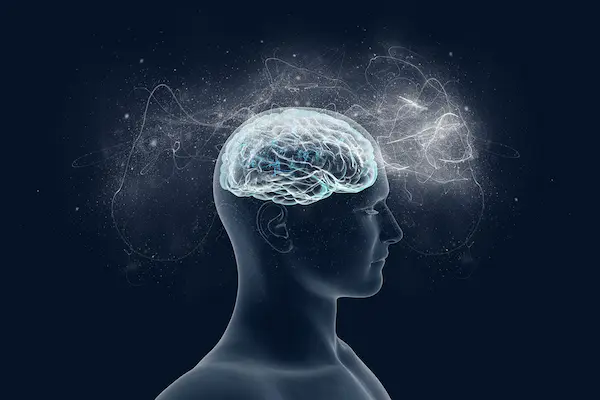
Can NAD Therapy Improve Cognitive Performance?
NAD Therapy is gaining attention in research for its possible role in brain health. NAD+ (nicotinamide adenine dinucleotide) is a

Enhancing Energy with NAD+ Supplements
Energy is the driving force behind focus, movement, and recovery. When cells have less energy to work with, the body